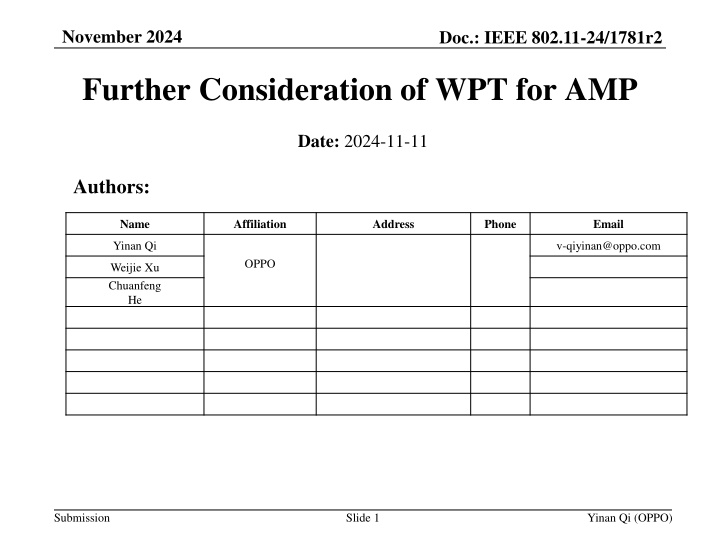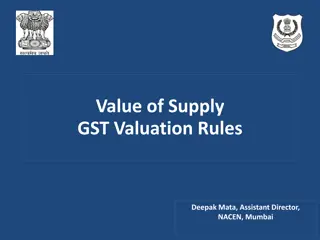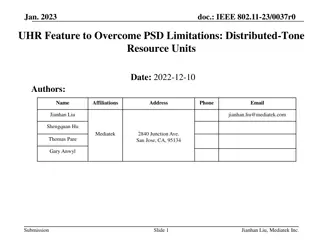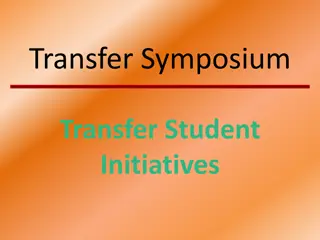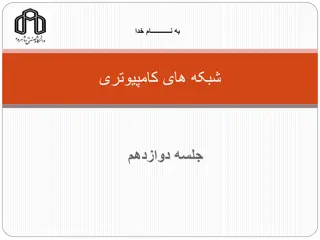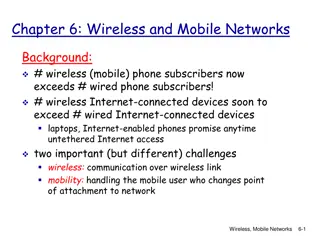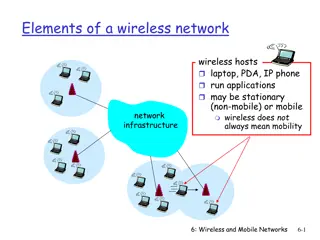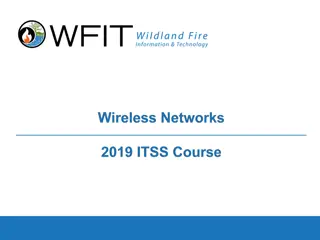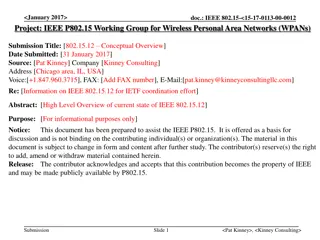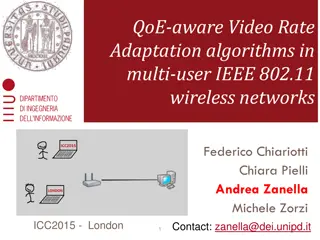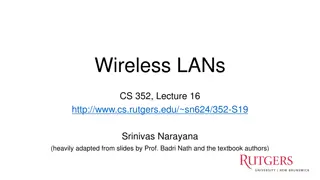Further Consideration of Wireless Power Transfer in IEEE 802.11-24
This document delves into Wireless Power Transfer (WPT) aspects like energizer control, feedback, signal waveform, and co-existence with S1G systems within IEEE 802.11-24. It discusses the behavior of energizers, energizer types, and their integration with AP devices. The proposed energizer topologies explore physical integration with AP devices and wired connections for power transfer signal transmission. Considerations for implementation and control mechanisms are highlighted.
Download Presentation

Please find below an Image/Link to download the presentation.
The content on the website is provided AS IS for your information and personal use only. It may not be sold, licensed, or shared on other websites without obtaining consent from the author.If you encounter any issues during the download, it is possible that the publisher has removed the file from their server.
You are allowed to download the files provided on this website for personal or commercial use, subject to the condition that they are used lawfully. All files are the property of their respective owners.
The content on the website is provided AS IS for your information and personal use only. It may not be sold, licensed, or shared on other websites without obtaining consent from the author.
E N D
Presentation Transcript
November 2024 Doc.: IEEE 802.11-24/1781r2 Further Consideration of WPT for AMP Date: 2024-11-11 Authors: Name Affiliation Address Phone Email Yinan Qi v-qiyinan@oppo.com OPPO Weijie Xu Chuanfeng He Submission Slide 1 Yinan Qi (OPPO)
Doc.: IEEE 802.11-24/1781r2 November 2023 Abstract In this contribution, we further discuss Wireless Power Transfer (WPT) including energizer control, AMP devices feedback/reporting, WPT signal waveform, WPT frame, etc., with focus on S1G. Submission Slide 2 Yinan Qi (OPPO)
November 2023 Doc.: IEEE 802.11-24/1781r2 Recap of Views Behaviour of energizers are fully controlled by the AP[1]. o Energizers and AP can be connected via either wired or wireless connections; o Controlling mechanisms and how to implement such mechanisms can be left to implementation. Power related signalling [2]. o In some case (e.g. sensors), AP can collect energy related information, e.g., remaining energy, energy harvesting capability, etc., from the AMP STA. o In some case (e.g. sensors), AMP STA can report its energy related information upon request from the AP. Co-existence with other S1G systems needs to be considered [1] Submission Slide 3 Yinan Qi (OPPO)
November 2023 Doc.: IEEE 802.11-24/1781r2 Definition of Energizer Type Integrated Type A: AP and energizer are integrated o AP can operate in both 2.4G and S1G frequency bands o No signalling exchange between AP and energizer o Same deployment density of AP Independent Type B: energizer is an independent device o Signalling between AP and energizer o Denser deployment for energizer o Low cost/complexity Submission Slide 4 Yinan Qi (OPPO)
November 2023 Doc.: IEEE 802.11-24/1781r2 Energizer Topology 1 Energizer is physically integrated with the AP/mobile AP, e.g. smart phone. No control signalling exchange between AP and energizer. o Smart phone can serve as an mobile AP. o All AMP UL/DL, WPT and wake-up signals are exchanged between AP/smart phone and AMP STA Submission Slide 5 Yinan Qi (OPPO)
November 2023 Doc.: IEEE 802.11-24/1781r2 Energizer Topology 2 Energizer is connected to the AP with wired connection. Control signalling between AP and energizer can be via high layer signalling, e.g., application layer. o Energizer can be always on and constantly transmits power transfer signal for AMP device energy harvesting. o WPT signal can be transmitted periodically from the energizer but the period can be configured/controlled by the AP. o WPT signal can be transmitted upon the request of the AP due to, e.g., the emerging DL traffic Submission Slide 6 Yinan Qi (OPPO)
November 2023 Doc.: IEEE 802.11-24/1781r2 Energizer Topology 3 Energizer is connected to the AP with wireless connection. Control signalling between AP and energizer is via wireless interface. Considering Wi-Fi as the wireless interface Case 1: Energizer and AP are independent and energizer is regarded as a non-AP STA associated with the AP Energizer should indicate to the AP that it is an energizer AP only activate the energizer when WPT signal or wake-up signal needs to be sent Case 2: Energizer and AP can be logically integrated AP does not see the energizer as an associated non-AP STA o o Submission Slide 7 Yinan Qi (OPPO)
November 2023 Doc.: IEEE 802.11-24/1781r2 WPT Protocol Part 1: define the control and signalling between energizer o Can be OOB but some key WPT info elements need to be defined, indication, duty cycle related, e.g., on time, period, etc. Part 2: define the reporting signalling between AP and AMP devices AP and AMP STA e.g., on/off Part 2 Part 1 Energizer AP Submission Slide 8 Yinan Qi (OPPO)
November 2023 Doc.: IEEE 802.11-24/1781r2 How/When to initiate WPT? Option 1: Periodic WPT o Light control and signalling o Can be initiated by Energizer autonomously o On/off, duty cycle can still be controlled by the AP o Consistent and predictable interference to co-existing systems Option 2: On demand WPT o Initiated by the AP autonomously based on long- term/short term reporting from AMP devices o Requested by the AMP devices Only for limited use cases, e.g. sensor Power status reporting may not be no longer needed Submission Slide 9 Yinan Qi (OPPO)
November 2023 Doc.: IEEE 802.11-24/1781r2 WPT Protocol Part 2 Long-term/Non-periodic feedback o Feedback info Harvesting capability Energy storage capability Etc. o Feedback once during activation or based upon the request of AP o Separate feedback reporting may be inefficient joint reporting of power category o Applied for all use cases Short-term/Periodic feedback o Power status/requirements o Feedback more frequently, can be optionally switched on/off o Only for limited use cases, e.g., sensor Submission Slide 10 Yinan Qi (OPPO)
November 2023 Doc.: IEEE 802.11-24/1781r2 WPT Protocol Part 2: Power Category Power categories (PC) can be defined based on the power features of the AMP devices [2] PC0: devices with extremely limited energy harvesting and power storage capability; PC1: devices with limited energy harvesting and power storage capability; PC2: devices with reasonable energy harvesting and power storage capability. The definition of PC can be based on the following features Energy harvesting capability including Power source(s) Energy harvesting efficiency Energy storage capability Whether or not energy storage is supported; The amount of energy that can be stored; Energy storage draining rate; Others RF energy harvesting operation frequency o o o o o o Submission Slide 11 Yinan Qi (OPPO)
November 2023 Doc.: IEEE 802.11-24/1781r2 WPT Signal Waveform Need to define waveform? o Specification: recommend one or multiple waveforms for WPT o Can be left to implementation Proactive v.s. Passive WPT o Proactive WPT: AP, energizer and AMP devices know exactly when and how to start or stop the WPT procedure. No need to always activate the RF harvesting circuit o Passive WPT: once the AMP devices detect signal strength above certain threshold, RF harvesting begins RF harvesting circuit needs to be on o Both should be allowed Legacy waveforms o Pros: easy to implement, minimal specification/implementation efforts o Candidates: OFDM, DSSS, single carrier, etc. Submission Slide 12 Yinan Qi (OPPO)
November 2023 Doc.: IEEE 802.11-24/1781r2 WPT Signal Waveform Legacy waveforms o OFDM High PAPR High efficiency Existing tech. Easy to implement o DSSS Existing tech. Easy to implement Spreading code noise like signal Low PAPR o Single Tone/Carrier Subset of OFDM Simple implementation Submission Slide 13 Yinan Qi (OPPO)
November 2023 Doc.: IEEE 802.11-24/1781r2 Co-existence Issue Dual communication in 2.4G o Difficult for the nodes to coordinate between WPT and communication of AMP devices. frequency operation: WPT in S1G but Submission Slide 14 Yinan Qi (OPPO)
November 2023 Doc.: IEEE 802.11-24/1781r2 WPT Frame Basically, communication signal needs to be avoided by the energizer but WPT signal can co-exist. Design WPT signal that can be fully or partially understood by the energizer. WPT signal can contain both WPT preamble and charging segment and the WPT preamble can be understandable to energizers. Submission Slide 15 Yinan Qi (OPPO)
November 2023 Doc.: IEEE 802.11-24/1781r2 WPT Frame Co-existence is not only WiFi compliant but also for other S1G systems o Energizer needs to understand not only Wi-Fi PPDU, e.g., 11ah, but also other S1G systems, leading to complicated design of preamble Smart Utility Networks, 470 510 MHz, 863 870 MHz, 902 928 MHz, and 920 925 MHz Low Energy, Critical Infrastructure Monitoring, operation frequency similar as SUN Low-Rate WPANs, operation frequency similar as SUN RFID, LoRa, etc. o New preamble design only to be understood by energizer Other systems can detect WPT signal via ED since their power is high Submission Slide 16 Yinan Qi (OPPO)
November 2023 Doc.: IEEE 802.11-24/1781r2 LBT for Energizers Energy Detection (ED) The energizer can do ED first. In the case of collision, the energizer needs to keep listening to the channel. Channel occupied (energy level > thresholdED) If a preamble is detected, the energizer Energizer does backoff knows the signal is WPT signal and it N Y N can transmit its own WPT signal. WPT preamble detected? Otherwise, it no preamble is detected, the energizer assumes the signal in the Y air is communication signal and does Transmit WPT signal backoff. Submission Slide 17 Yinan Qi (OPPO)
November 2023 Doc.: IEEE 802.11-24/1781r2 Summary In this submission, we discuss the following issues for WPT: o Energizer definition o WPT protocols o WPT waveforms o WPT frame design o LBT procedure for energizer Submission Slide 18 Yinan Qi (OPPO)
November 2023 Doc.: IEEE 802.11-24/1781r2 Reference 1. IEEE 802.11-24/1536r0 Wireless Power Transfer for AMP 2. IEEE 802.11-24/1381r0 AMP Device Power Status Submission Slide 19 Yinan Qi (OPPO)
November 2023 Doc.: IEEE 802.11-24/1781r2 SP1 Do you agree that the following topologies as shown in the below figures for energizer should be considered in 11bp and captured in SFD? Topology 1: Energizer is physically integrated with the AP. Topology 2: Energizer is connected to the AP with wired connection. Topology 3: Energizer is connected to the AP with wireless connection. The details of the wireless connection are TBD Topology 1 Topology 2 Topology 3 Submission Slide 20 Yinan Qi (OPPO)
November 2023 Doc.: IEEE 802.11-24/1781r2 SP2 Do you agree to capture the following text to TGbp SFD? o AMP devices shall report power category to the AP during activation or upon the request of the AP? The details on how to define power category are TBD Submission Slide 21 Yinan Qi (OPPO)
November 2023 Doc.: IEEE 802.11-24/1781r2 SP3 Do you agree to capture the following text to TGbp SFD? o 11bp supports OFDM and single carrier as WPT waveforms? Submission Slide 22 Yinan Qi (OPPO)
November 2023 Doc.: IEEE 802.11-24/1781r2 SP4 Do you agree to capture the following text to TGbp SFD? o 11bp specifies, in S1G, WPT PPDU format with at least a preamble and a charging field? Submission Slide 23 Yinan Qi (OPPO)
